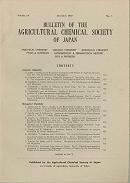Volume 23, Issue 2
Displaying 1-16 of 16 articles from this issue
- |<
- <
- 1
- >
- >|
-
1959Volume 23Issue 2 Pages 73-77
Published: 1959
Released on J-STAGE: November 27, 2008
Download PDF (362K) -
1959Volume 23Issue 2 Pages 78-82
Published: 1959
Released on J-STAGE: November 27, 2008
Download PDF (321K) -
1959Volume 23Issue 2 Pages 83-88
Published: 1959
Released on J-STAGE: November 27, 2008
Download PDF (413K) -
1959Volume 23Issue 2 Pages 89-94
Published: 1959
Released on J-STAGE: November 27, 2008
Download PDF (341K) -
1959Volume 23Issue 2 Pages 95-99
Published: 1959
Released on J-STAGE: November 27, 2008
Download PDF (281K) -
1959Volume 23Issue 2 Pages 100-106
Published: 1959
Released on J-STAGE: November 27, 2008
Download PDF (516K) -
1959Volume 23Issue 2 Pages 107-109
Published: 1959
Released on J-STAGE: November 27, 2008
Download PDF (183K) -
1959Volume 23Issue 2 Pages 110-115
Published: 1959
Released on J-STAGE: November 27, 2008
Download PDF (407K) -
1959Volume 23Issue 2 Pages 116-120
Published: 1959
Released on J-STAGE: November 27, 2008
Download PDF (320K) -
1959Volume 23Issue 2 Pages 121-125
Published: 1959
Released on J-STAGE: November 27, 2008
Download PDF (788K) -
1959Volume 23Issue 2 Pages 126-130
Published: 1959
Released on J-STAGE: November 27, 2008
Download PDF (370K) -
1959Volume 23Issue 2 Pages 131-136
Published: 1959
Released on J-STAGE: November 27, 2008
Download PDF (1302K) -
1959Volume 23Issue 2 Pages 137-138
Published: 1959
Released on J-STAGE: November 27, 2008
Download PDF (129K) -
1959Volume 23Issue 2 Pages 138-140
Published: 1959
Released on J-STAGE: November 27, 2008
Download PDF (594K) -
1959Volume 23Issue 2 Pages 140-141
Published: 1959
Released on J-STAGE: November 27, 2008
Download PDF (98K) -
1959Volume 23Issue 2 Pages 141-142
Published: 1959
Released on J-STAGE: November 27, 2008
Download PDF (77K)
- |<
- <
- 1
- >
- >|
